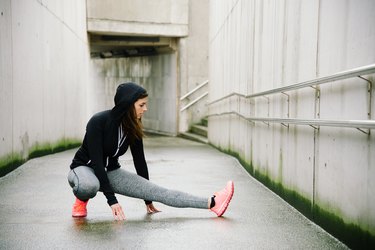
If you have lower back pain, you're not alone. At any given time, more than 30 million Americans are also experiencing lower back pain, reports the American Chiropractic Association. Not only is it the most common reason for disability in the world, but it's also the second most common reason for missed work.
The causes of lower back pain are numerous, from a sports injury to diseases of the internal organs. Another common cause is tightness in another area of your body, such as your hamstrings. Perform hamstring stretches for lower back pain.
Video of the Day
Video of the Day
Tip
Hamstring tightness can contribute to low back pain, as these muscles attach to the back of your pelvis.
Tight Hamstrings and Back Pain
Your lower back is one of the most important parts of the body. In combination with your abdominal and oblique muscles, it makes up your body's core — literally, your center. The core is an area that controls most of your movements, from holding your body upright to walking, lifting and reaching.
As the center of your body, the lower back is susceptible to the effects of injuries or limitations in other areas of your body. Shortened hip flexors — the muscles on the front of your pelvis and top of your thighs — pull the spine into hyperlordosis, or a lower back the overarches. In the same way, tight hamstrings and back pain are related. Tight hamstrings pull on the lower back, causing the hips and pelvis to rotate backward. This leads to a flattened lower back.
A lower back that is either over-arched or flattened stresses the lower back muscles and often leads to muscle weakness and pain.
Read more: Quad & Hamstring Stretches
Test Your Hamstring Flexibility
You probably know if you have tight hamstrings, especially if you're active and pay attention to your body. Simply bending over and trying to touch your toes can tell you if your hamstrings are tight.
Can you touch your toes? If not, you have tight hamstrings. Do you feel pain in the backs of your thighs or behind your knees when you try to touch your toes? If the answer is yes — bingo, tight hamstrings.
If you want to get more technical and judge the degree of your hamstrings' tightness, you can use an inexpensive goniometer, a device that measures angles, in this case, the angle between your leg and the floor during a lying straight-leg raise. It's easiest to have someone help you do this test.
HOW TO DO IT: Lie on the floor with your legs extended and your arms at your sides. Raise one leg into the air, keeping it straight. Raise it as high as you can without your back arching, knee bending or pain. Have your helper measure the angle between that leg and the floor. Then, do the other side.
If the angle measured is greater than 80 degrees, your hamstring flexibility is good to excellent and may not be the cause of your lower back pain. If you got a measurement below 79 degrees, your hamstring flexibility is fair to poor — a good sign that the tightness may be affecting your lower back and causing pain.
Of course, you'll want to get a second opinion from a medical professional, who can perform further tests to give you a definitive diagnosis.
Read more: The DOs and DON'Ts of Foam Rolling
Stretch to Increase Flexibility
Incorporate hamstring stretches for lower back pain in your regular workout routine. You can also try self-myofascial release with a foam roller and visit a massage therapist for some sports massage sessions.
1. Standing Hamstring Stretch: From a standing position, bend forward at the hips. Allow your arms to hang down and keep the legs relatively straight, and don't round the back. Stop when you feel a stretch in the hamstrings, even if your back hasn't reached parallel with the ground. Overstretching will make your back problems worse.
If you find the standing hamstring stretch to put too much pressure on your lower back, try the seated version.
2. Chair Hamstring Stretch: Sit in a chair and extend your legs straight out in front of you with your heels on the floor. Keeping a straight spine, reach for your toes only until you feel a stretch in your hamstrings. You can also do one foot at a time, bending one knee and placing the foot flat on the floor, and reaching for the toes of the opposite extended leg.
3. Foam Rolling: Self-myofascial release with a foam roller uses your body weight to place pressure on tight muscles to help tight muscles release. Place the foam roller under your hamstring and slowly roll back and forth over small sections of the muscle. When you come to a tender spot, hold for 30 to 45 seconds.